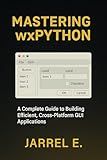Best WxPython GUI Tools to Buy in January 2026
In wxPython, ListCtrl is a versatile widget used to display a list of items in various formats such as report view, icon view, and list view, similar to the file explorer in operating systems. To use ListCtrl in wxPython, you first need to import the wx module and create an instance of wx.ListCtrl within your frame or panel. You can then define its style by choosing from options like wx.LC_REPORT for a multi-column report view or wx.LC_ICON for large icons. Initialize the control by setting up any columns if using wx.LC_REPORT. You can add items to the list using methods like InsertItem, SetItem, and Append. Handling events such as item selection, activation, or modification is possible by binding event handlers to events like EVT_LIST_ITEM_SELECTED or EVT_LIST_ITEM_ACTIVATED. To enable sorting or editing capabilities, you can implement appropriate methods or event handlers. Using sizers can help in managing the layout of the ListCtrl along with other widgets, ensuring it resizes appropriately with the window. Set the data model for large datasets by leveraging virtual list controls, which only retrieves data for visible items, enhancing performance.
How to enable item selection in ListCtrl?
To enable item selection in a ListCtrl in a wxPython application, you need to set the appropriate style for the ListCtrl widget when you create it. By default, a ListCtrl does allow selection, but you can customize how selection is performed using different styles.
Here's a basic example of how to enable item selection in a ListCtrl with a wxPython application:
import wx import wx.lib.mixins.listctrl as listmix
class MyFrame(wx.Frame): def __init__(self, parent, title): super(MyFrame, self).__init__(parent, title=title, size=(400, 300))
# Create a panel and a ListCtrl widget
panel = wx.Panel(self)
sizer = wx.BoxSizer(wx.VERTICAL)
# Create the ListCtrl with some styles
self.list\_ctrl = wx.ListCtrl(panel, style=wx.LC\_REPORT | wx.BORDER\_SUNKEN | wx.LC\_SINGLE\_SEL)
# Enable headers if necessary
self.list\_ctrl.InsertColumn(0, 'Column 1')
self.list\_ctrl.InsertColumn(1, 'Column 2')
# Append sample data
index = self.list\_ctrl.InsertItem(0, "Item 1")
self.list\_ctrl.SetItem(index, 1, "Value 1")
index = self.list\_ctrl.InsertItem(1, "Item 2")
self.list\_ctrl.SetItem(index, 1, "Value 2")
# Add the ListCtrl to the sizer
sizer.Add(self.list\_ctrl, 1, wx.EXPAND)
panel.SetSizer(sizer)
# Event binding for item selection
self.list\_ctrl.Bind(wx.EVT\_LIST\_ITEM\_SELECTED, self.OnItemSelected)
def OnItemSelected(self, event):
# Get the selected item's index
item\_index = event.GetIndex()
item\_text = self.list\_ctrl.GetItemText(item\_index)
print(f"Selected item: {item\_text}")
class MyApp(wx.App): def OnInit(self): frame = MyFrame(None, "ListCtrl Example") frame.Show() return True
if __name__ == "__main__": app = MyApp(False) app.MainLoop()
Important Points:
- Styles: The wx.LC_REPORT style is used to enable list view with columns, which is often the most useful view for seeing why selection doesn't work. wx.LC_SINGLE_SEL forces single selection mode, so only one item can be selected at a time. For multiple selections, you would use wx.LC_MULTIPLE_SEL.
- Events: Bind the wx.EVT_LIST_ITEM_SELECTED event to a handler method to perform actions when an item is selected.
This example demonstrates how items can be selected in a ListCtrl and how to handle selection events. Adjust the styles based on your specific requirements for allowing multiple selections, column headers, etc.
How to use ListCtrlAutoWidthMixin in wxPython?
The ListCtrlAutoWidthMixin in wxPython is a mixin class that you can use to automatically adjust the width of the last column in a wx.ListCtrl widget. This is particularly useful for ensuring that the list control fills its allocated space within a window and its content does not overflow.
Here's how you can use ListCtrlAutoWidthMixin in your wxPython application:
- Import the necessary modules: First, you need to import wx and the classes you're going to use from wx.lib.mixins.listctrl.
- Subclass wx.ListCtrl with the Mixin: Create a new class that inherits from both wx.ListCtrl and wx.lib.mixins.listctrl.ListCtrlAutoWidthMixin.
- Initialize the mixin: In the constructor of your subclass, initialize both wx.ListCtrl and ListCtrlAutoWidthMixin.
Here's an example that puts these steps together:
import wx import wx.lib.mixins.listctrl as listmix
class AutoWidthListCtrl(wx.ListCtrl, listmix.ListCtrlAutoWidthMixin): def __init__(self, parent, id=wx.ID_ANY, pos=wx.DefaultPosition, size=wx.DefaultSize, style=0): super(AutoWidthListCtrl, self).__init__(parent, id, pos, size, style)
# Initialize the mixin
listmix.ListCtrlAutoWidthMixin.\_\_init\_\_(self)
class MyFrame(wx.Frame): def __init__(self, parent, title): super(MyFrame, self).__init__(parent, title=title, size=(500, 300))
panel = wx.Panel(self)
# Use the custom class instead of wx.ListCtrl
list\_ctrl = AutoWidthListCtrl(panel, style=wx.LC\_REPORT)
# Add columns
list\_ctrl.InsertColumn(0, 'Column 1')
list\_ctrl.InsertColumn(1, 'Column 2')
list\_ctrl.InsertColumn(2, 'Column 3')
# Add some data
for i in range(10):
index = list\_ctrl.InsertItem(i, f"Row {i+1} - Col 1")
list\_ctrl.SetItem(index, 1, f"Row {i+1} - Col 2")
list\_ctrl.SetItem(index, 2, f"Row {i+1} - Col 3")
sizer = wx.BoxSizer(wx.VERTICAL)
sizer.Add(list\_ctrl, 1, wx.EXPAND | wx.ALL, 10)
panel.SetSizer(sizer)
self.Show()
class MyApp(wx.App): def OnInit(self): frame = MyFrame(None, "ListCtrlAutoWidthMixin Example") self.SetTopWindow(frame) return True
if __name__ == "__main__": app = MyApp(False) app.MainLoop()
Key Points:
- Mixin Concept: The ListCtrlAutoWidthMixin is not used directly; instead, it is mixed into your wx.ListCtrl subclass.
- Auto Width: The mixin automatically handles the resizing of the last column to take up remaining space in the parent window.
- Initialization: Make sure to call the mixin's constructor within your own class's constructor.
This setup ensures your list control has a dynamic layout that adapts to the window size, which can enhance the user interface of your application.
How to resize columns in a ListCtrl?
Resizing columns in a ListCtrl can be done in various ways depending on the GUI framework you are using. I'll explain how to do this in some common frameworks: wxPython, Windows Forms (WinForms) in .NET, and PyQt/PySide. If you specify the framework you're using, I can provide more tailored guidance.
wxPython
In wxPython, ListCtrl is a part of the wx.ListCtrl class. You can resize the columns dynamically or set fixed widths:
- Set Fixed Width: list_ctrl.SetColumnWidth(col_index, width) Replace col_index with the index of the column and width with the desired width in pixels.
- Auto-size Columns: list_ctrl.SetColumnWidth(col_index, wx.LIST_AUTOSIZE) This will resize the column to fit the longest item in it.
- Auto-size to Header: list_ctrl.SetColumnWidth(col_index, wx.LIST_AUTOSIZE_USEHEADER) This will resize the column to fit the header text length.
Windows Forms (.NET)
In Windows Forms, ListView is used, and the columns are part of a ListView.ColumnHeaderCollection.
- Set Fixed Width: listView1.Columns[colIndex].Width = width;
- Auto-size Columns: Use the AutoResize method: listView1.AutoResizeColumn(colIndex, ColumnHeaderAutoResizeStyle.ColumnContent);
- Auto-size to Header: listView1.AutoResizeColumn(colIndex, ColumnHeaderAutoResizeStyle.HeaderSize);
PyQt/PySide
For PyQt/PySide, QTableWidget or QTreeWidget is typically used for displaying tables or lists with headers:
- Set Fixed Width: table_widget.setColumnWidth(col_index, width)
- Auto-size Columns: You can use the resizeColumnsToContents() method for automatic resizing based on the content: table_widget.resizeColumnsToContents()
- Manual Adjustment (typically using drag): Most of the modern GUI frameworks allow columns to be manually resized by the user with the mouse.
If you're using a different framework or need more specific code examples, feel free to provide more details!
What is the purpose of InsertStringItem in ListCtrl?
In the context of a wx.ListCtrl in the wxWidgets library, the InsertStringItem function is used to insert a new item (or row) into the list control with a specified text label, usually for the first column. It simplifies the process of adding new entries to a list view, especially when dealing with textual data.
Here are some key points about InsertStringItem:
- Position: You specify the position (or index) at which the item should be inserted. This determines where in the list the new item will appear.
- Label: This is typically the main text you want to show in the list item's first column. This could be a name, description, or any string relevant to the application.
- Return Value: The function returns the index of the newly inserted item, which is useful if you need to reference the item later, for adding additional columns, or for other operations.
- Additional Columns: After inserting the item with InsertStringItem, you can use other methods like SetItem to fill out additional columns for that item.
- List Types: InsertStringItem is often used when the list control is in "report" mode (i.e., with columns), where items are represented as rows and can have multiple columns.
Overall, InsertStringItem is a convenient method for developers to manage dynamically updating lists within a wxWidgets application, allowing for straightforward insertion of text-based data into list controls.
How to retrieve selected items from a ListCtrl?
To retrieve selected items from a ListCtrl in a wxPython application, you need to iterate through the items and check their selection status. Here's a step-by-step guide to accomplish this:
Step 1: Setup Your ListCtrl
First, ensure you have a ListCtrl set up in your wxPython application. This is typically part of a larger GUI that includes item(s) you want to select.
import wx import wx.lib.mixins.listctrl as listmix
class ListCtrlExample(wx.Frame): def __init__(self, *args, **kwargs): super(ListCtrlExample, self).__init__(*args, **kwargs)
# Create a panel
panel = wx.Panel(self)
# Initialize a ListCtrl
self.list\_ctrl = wx.ListCtrl(
panel,
style=wx.LC\_REPORT | wx.BORDER\_SUNKEN
)
# Insert columns
self.list\_ctrl.InsertColumn(0, 'ID', width=100)
self.list\_ctrl.InsertColumn(1, 'Name', width=100)
# Insert items into the ListCtrl
self.list\_ctrl.InsertItem(0, '1')
self.list\_ctrl.SetItem(0, 1, 'Item One')
self.list\_ctrl.InsertItem(1, '2')
self.list\_ctrl.SetItem(1, 1, 'Item Two')
self.list\_ctrl.InsertItem(2, '3')
self.list\_ctrl.SetItem(2, 1, 'Item Three')
# Layout
sizer = wx.BoxSizer(wx.VERTICAL)
sizer.Add(self.list\_ctrl, 1, wx.EXPAND)
panel.SetSizer(sizer)
# Create a button to retrieve selected items
button = wx.Button(panel, label='Get Selected Items')
sizer.Add(button, 0, wx.ALL | wx.CENTER, 5)
# Bind the button event
button.Bind(wx.EVT\_BUTTON, self.on\_get\_selected\_items)
def on\_get\_selected\_items(self, event):
selected\_items = \[\]
index = self.list\_ctrl.GetFirstSelected()
while index != -1:
item\_data = self.list\_ctrl.GetItemText(index)
selected\_items.append(item\_data)
index = self.list\_ctrl.GetNextSelected(index)
print("Selected items:", selected\_items)
Run the application
if __name__ == '__main__': app = wx.App(False) frame = ListCtrlExample(None, title='ListCtrl Example', size=(300, 200)) frame.Show() app.MainLoop()
Explanation
- Setting up the ListCtrl: Create a wx.ListCtrl with wx.LC_REPORT style for a report view, allowing for multiple columns.
- Adding Items: Use InsertItem to add rows to your list control and SetItem to set the value of specific columns.
- Getting Selected Items: In the on_get_selected_items method: Use GetFirstSelected() to get the first selected item index. Iterate through the selected items using GetNextSelected() to get subsequent selected indices. For each selected index, GetItemText(index) retrieves the item text.
- Bind Button Event: A button is added to trigger the retrieval of selected items. The bound event will print the selected items in the console.
This script creates a simple GUI application where you can select items in a ListCtrl. By clicking the "Get Selected Items" button, the console will display the selected items' IDs. Adjust as needed to match your application's requirements.



